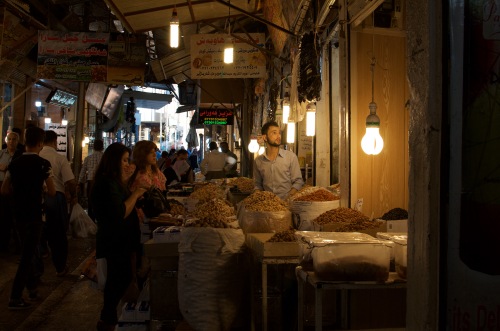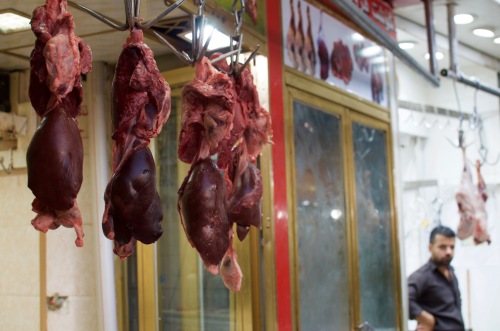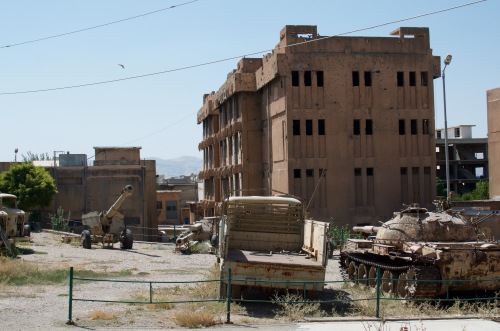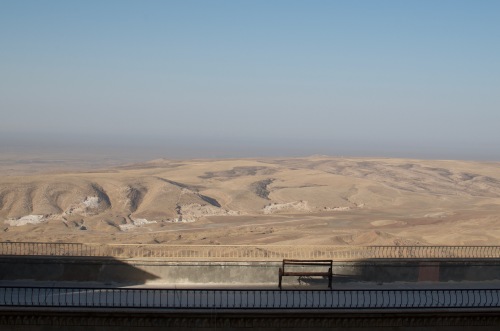Massacres and Monasteries: Remembrance and Resilience in Iraqi Kurdistan
by kfo290
Despite breezy references in news reports to “the Kurds” and “Kurdistan” as presumably unified entities, the groupings these simplistic labels refer to are in fact rife with divisions. Between Kurdish factions in Syria, Iraq, Iran and Turkey there are linguistic, tribal, cultural, political and strategic differences, certainly, but competing groups within Iraqi Kurdistan itself have effectively cleaved the semi-autonomous region in two, each half governed by a distinct regional authority. In Erbil, to the north, the Kurdistan Democratic Party (KDP), presided over by President Masoud Barzani and his clan, holds sway; in Sulaymaniyah and the south, the Patriotic Union of Kurdistan (PUK), led by Jalal Talabani, rules.
This power-sharing agreement emerged from a civil war fought between KDP and PUK from 1994 to 1998, but tensions between the parties remain problematic. The power struggle between the two has been complicated further in recent months by an alliance forged between the PUK and the Movement for Change (aka Gorran: a third major player that has consistently presented itself as anti-establishment and vehemently against corruption), to challenge the dominance of the KDP. The shifting dynamics have important implications for the Kurdistan Regional Government’s dealings with Baghdad, as well as their relations with Syrian Kurdish groups and the Turkish government.
A fortnight into my trip through Kurdistan, I’d spent time only in KDP land. In my last week, I headed south to Suli, crossing the invisible line into PUK territory. I barely registered the difference. The only noticeable border zone on the bus ride between Erbil and Slemani (the Kurds’ Latinate spelling of Sulaymaniyah) materializes on the stretch of road between our destination and the contested, oil-rich city of Kirkuk. Recently incorporated into the Kurds’ expanding territory, Kirkuk has seen sporadic clashes between Kurdish forces and Shia militias in the past year. In July, militants managed to breach security and attack a gas facility and an oil field just west of the city; Reuters reported that the assailants were affiliated with ISIS, which still holds land in Kirkuk province.
Perhaps because of this instability, security between Kirkuk and Suli is particularly tight. With thirty minutes to go, the mini-bus crawls to a stop in a vast parking lot alongside hundreds of other vehicles (we’re a few days into Eid, so traffic is particularly heavy), our passports demanded by a terse official. Several of the passengers are told to get out to have their documents scanned. The old woman left in the bus with me makes the driver buy her a bright pink and white-striped ice cream, which she proceeds to offer to me, then eat with relish while we wait. Bored and restless, I go for a wander, snapping pictures of the roiling crowd outside the offices. Occasionally, an official emerges and calls some names, and a few men dash forward eagerly to grab their papers.
I stroll back to the bus and soon enough an Asayish officer taps me on the shoulder, demanding my phone. He delicately scrolls through photos before uttering a terse order—“Delete!”—and trotting off again. A hot wind flutters the PUK posters lining the highway. Finally, we’re on our way into the city.
Suli, nominally Iraqi Kurdistan’s capital of culture, is spread across a shallow valley, ringed by mountains. Recent PUK statistics suggest a population of 2.5 million (including IDPs and Syrian refugees), although this number far exceeds the IOM estimate of 1.8 million. Whatever the real figure, Suli—unlike Erbil—feels like a fully fledged, organic city, with a bustling bazaar at its centre, a vibrant street life, and suburbs stretching up into the hills. The city emits a relaxed atmosphere compared to the relative conservatism of the capital; small cafes and interesting bars are tucked into the meandering streets, and women’s fashion runs the gamut from colorful hijabs, to chadors, to racily short skirts (ie. above the calf). The weeklong Eid holiday has seen an influx of tourists from the rest of Iraq, and Bermuda-shorts-wearing Baghdadis stroll the city streets, sipping juices and snapping selfies.
Eid is a time for receiving and visiting family and friends, indulging in a cheerful carousel of sweets, pastries and pleasantries. Guests stop by frequently at the home I’m staying in (hosted by a medical student, Ahmed, and his family)—elderly relatives and youthful friends of the house’s teenagers alike are fed little pots of custard, while the lady of the house bustles about in vibrant Kurdish outfits, her jewel-colored dresses overlaid with sparkling waistcoats and offset with dramatic gold accessories. Despite this non-stop entertaining, she finds time to provide platefuls of substantial Kurdish cooking: rice pilaf, beans swimming in tomato gravy, aubergines stuffed with lamb.
Each breakfast with my Suli family is a feast of fresh bread, eggs, tomatoes, cucumbers, and fantastically zingy yoghurt made by a cattle-raising branch of the clan. Sometimes these morsels are accompanied by lentil soup, tinted sunshine-yellow with turmeric. One lunch, Ahmed’s mother labors for hours to produce vegetarian yaprak (dolma): a heaping platter of silky onion, chard, peppers, tomatoes and eggplants, stuffed with a savory rice mixture rendered unctuous with liberal quantities of olive oil. Almost all of the vegetables we eat are grown in the family garden, just outside the city: sun-sweetened knobbly tomatoes, crisp baby cucumbers.
The household feels busy, productive, thriving—but my hosts, like most families in Kurdistan, have been hit hard by the economic crisis. Ahmed’s father receives 35% of his regular salary, while his mother, a medical aide, is on reduced hours. When I visited, Ahmed, working a part-time job for independent income, was uncertain whether his studies would resume in the fall, given the financial situation of Kurdistan’s universities.
During my travels, one young Kurd informed me, proudly, that there were no income taxes in Kurdistan—but the lack of tax revenues and Iraqi government support, coupled with a swift plunge in the price of oil (with Kurdish oil receiving almost as low as US $30 a barrel), has left the KRG in dire financial straits. Not that you’d know it from a wander through Suli’s parks: family groups and gangs of teenagers stroll along shaded paths or sprawl on well-tended lawns, the picture of a contented populace.
One day, we drive out of the city, through rolling hills and up into a cave-riddled valley. A small waterfall has taken on a carnival aspect, engulfed by crowds of local tourists and buzzing with small businesses (men touting horse-rides, chai, ice-cream, fruit). After a lavish picnic, we drive on, to an ancient relief carved into a rock face in the hillside. Two Assyrian figures—reminiscent, to me, of Persian sculpture—salute a central plinth, which bears a stylized mound that may represent either a sacred fire or a burial shroud. The men seem to be warriors: both clutch bows. In a separate panel, a priestly figure holds a torch aloft. To the left is a Faravahar: a human figure astride a winged disc. Usually the Faravahar, a Zoroastrian symbol, clasps a ring in one hand, above a single set of wings. Here, the wings are doubled, and the figure holds a torch rather than a ring—presumably an Assyrian take on the Persian original. On the panel opposite, a many-sided star represents Ishtar, goddess of fertility, war, sex and power.
In the evening, we stop by Chavi Land, a theme park set high on a hill overlooking Suli. The Eid crowds, many dressed in their best Kurdish outfits—flowing shimmery dresses for the women and smart wide-legged suits for the men—thicken around food stalls and rides. A solitary small girl, in a sparkling pastel-pink frock, frilly white socks and sandals, clutches a candyfloss pouf (exactly the same shade as her dress) in one hand, like a balloon. A gondola whirrs overhead, in the darkening evening sky, ferrying visitors to the top of a nearby mountain. We join the queue, and look out from the summit’s restaurant terrace, over the spidery lights of the city.
Not all of Suli is so charming. Crouched like a bad dream on a nondescript street corner is the Amna Suraka—the Red Security museum, a remnant of Saddam Hussein’s nightmare rule. Once used by the Mukhabarat, Saddam’s intelligence service, as a combination office space-torture chamber-prison, the large complex of battle-scarred buildings—old tanks and armored anti-aircraft guns hunkered down between blocks—exudes an air of quiet menace. The museum now memorializes both Saddam’s vicious legacy, and Kurdistan’s culture and history of resistance.
A narrow corridor, made dream-like, exquisite with mirror-shards and fairy lights, commemorates the many victims of Saddam’s genocidal Al Anfal operation, in which 182,000 individuals (each represented by a mirror fragment) lost their life. The 4500 light bulbs, meanwhile, symbolize the villages demolished in the ruthless campaign. One building hosts a colorful display of Kurdish textiles, ornaments, weaponry. The next, in sharp contrast, preserves the warren of interrogation chambers and cells in which prisoners were kept in abject conditions and subject to extreme forms of torture. White sculptures of inmates (often in attitudes of torment) and translations of the copious graffiti give a sense of what life in these miserable rooms was like.
A photography display in the next building documents the desperate exodus prompted by Saddam’s extermination offensive—painfully reminiscent of today’s refugee crisis—while a separate series of rooms commemorates the guerrilla movement that resisted the regime from the relative safety of the mountains.
The calculated depravity and ruthlessness of that era is perhaps most evident a few hours drive from Suli, at Halabja—site of the deadliest chemical weapons attack in human history. A small town close to the Iranian border, Halabja was bombarded heavily with mustard gas and the nerve agent sarin in March 1988, during the Iran-Iraq war, shortly after the settlement had been captured in a surprise advance by the Iranian Revolutionary Guard. The chemical assault killed up to 6,800 Kurds, most of them civilians, many of whom had fled into subterranean bunkers to sit out the bombing. The gas cocktail, heavier than air, followed them below ground. Thousands were injured—skin blistered, lungs and eyes chemically seared—and the effects of the gas are still being felt, with latent chemical damage emerging as cancer, infertility and birth defects.
As you enter Halabja, a sculpture appears on your right, looking—to me—like vast metallic hands clasped upwards in prayer or despair. The monument houses a museum commemorating the massacre and its many victims. Photographs of the aftermath are traumatic testimony to the effects of the gas: bodies lie crumpled across the landscape, like toys tossed aside. White foam bubbles from slack mouths. A strange blue tint touches blistered, swollen skin. A dead man, face down, clutches a dead baby to his breast. These are photographs that are painful, almost repulsive, to look at: deadly and disquieting.
Modern Halabja spreads out in nondescript streets beneath the jagged mountains that divide Iran and Iraq. A few years after the attack, many residents began to return. But by 2006, the slowness of the rebuild had stoked anti-government sentiment. Protests that year left the monument destroyed, and prompted the Kurdish government to dedicate more funds to Halabja. One year on, the town still had no running water and no functional sewerage system. The day I visited, central Halabja was quiet—very few shops were open at midday, and the streets were sparsely occupied; much of the town feels raw, unfinished. A large mosque is being built on scarred land overlooking the centre.
I stop for vegetables, and end up being detained briefly by some bored Asayish guys, who are loitering on the corner and bemused by my solitary presence. Why am I here, they want to know. What am I doing in Halabja? I suppose they think I might be a spy—not an uncommon assumption in this part of the world. They peruse my passport, squinting at the pages of entry stamps. They request to see my camera, clicking through recent photographs (luckily no selfies). They radio their higher-up for instructions, while the cheerful vegetable man asks me to take a photo of him. After about ten minutes, they get the all clear, and I break up our little street party, to continue my exploration.
On the bus home, I glance out of the window just in time to see a Toyota pick-up truck speeding by, a uniformed peshmerga soldier—ponytail tucked through his cap—standing in the back, leaning against the wind and clinging to an anti-aircraft gun to prevent too much swing: heading, presumably, to the frontline.
Interactions with the Asayish are a regular feature of Kurdistan life, and a few days later my companions and I find ourselves explaining our movements once again—this time armed with an official document demanding our safe and unhindered passage, as we try to pass the last checkpoint before the frontline. We’ve travelled north from Erbil, bumping over progressively smaller roads and passing a giant fish statue and an extremely organized-looking refugee camp, en route to Mar Mattei monastery—a holy sanctuary embedded high in the mountains overlooking the Nineveh plains, run by Syrian Orthodox monks.
Our innocent pilgrimage plan to spend a night at the monastery is met with mild skepticism by the guards at the final Asayish outpost. My companion’s abundant beard has got them jumpy. Are we sure we’re not heading for the frontline, they ask—obviously wary that we either want to join the combat or are aspiring war tourists. “I really don’t want to see Daesh,” I assure our interlocutor, an officer with an American tinge to his English, who insists we call him Jimmy. “Me neither!” he says, with a grin. Finally, after a quick phone call up to the monks to let them know we’re coming (and a strict injunction not to photograph the frontline), we pass through the checkpoint, continuing along the Mosul road before mercifully swinging to the right, heading for Mt Alfaf.
The flat, brown face of the monastery seems to emerge organically from the parched slopes, an almost fortress-like façade gazing implacably out over the hazy, rumpled sheet of the plains. We pass through crucifix-studded doors beneath the central onion dome and wander through the main courtyard, hushed voices bouncing off honey-colored stone as we make our way to the office of Father Yusuf. Ushered inside, the Father immediately makes us at home, offering wrapped candies. A jovial man, in the embroidered black cap of his order, with a sweet smile and an easy laugh, Father Yusuf settles in to tell us the story of the monastery, which stretches back to the 4th century. “There were seven thousand monks in the ninth century,” he says, with a sad smile. “Now we are seven.”
Two days before we arrived, Father Yusuf tells us, the monks celebrated the feast of their patron saint, St Matthew, with a thousand guests in attendance. “I am so proud,” he says quietly, reflecting on the event. Welcoming in the outside world, breaching the geographical isolation of the monastery, seems a matter of existential importance. Later, over dinner, I ask him how things were in 2014, as ISIS overwhelmed nearby Mosul—only 20 kilometres away. “We were so afraid,” he says, simply. “With the retreat of the peshmerga, we really felt we were alone.” When we thank Yusuf profusely for his hospitality—the comfortable room we’ve been given, the meal we’ve been fed—he looks at us in kindly bafflement. “Thanks for what?” he asks. “This is everyone’s home.”
One family from Mosul has been living in the monastery since their home was overrun. Other pilgrims we meet are from villages on the plains that have also been taken by the militants. Little Daniel is here with his father, Boutros—a beekeeper and electrician who eagerly offers us a taste of his honey. Father Thomas, a serious man in his mid-thirties, has been living in Mar Mattei for twenty years. One guest, a cheerful joker also named Yusuf, flaps us away when we try to cook, and instead whips up an eclectic feast himself. The table is spread with dishes: rice studded with chicken, raisins and almonds; pasta with tomato sauce; mediocre hummus from a tin that has been reinvigorated with fresh oil and garlic and salt and lemon; red cabbage salad; pickles; olives grown and prepared at the monastery; piles of bread; beans stewed in gravy.
After the meal, we climb up above the monastery’s ancient walls—remnant of an earlier incarnation—and watch lights appear on the blank canvas of the plains. We can see the faint glow of Mosul in the distance. Much closer, the regular lights of the frontline make the fortifications look like a highway, before the black buffer of no-man’s-land.
Mar Mattei—one of the oldest Christian monasteries in existence—is surrounded by sacred geographies: caves, trees and shrines that each have a history, a meaning. We spend the next morning exploring, scrambling around the mountains and up and down the several floors of the monastery itself. We discover an ancient well, massive and empty of water, the aperture at the apex allowing morning light to sift slowly down through dusty air. At the bottom of the ladder, our voices echo in the musty dark. We leave at midday, sadly unable to take Father Yusuf up on his offer of his lunch, and make our way back to Erbil—this time going in the right direction, speeding through the roadblocks, away from the frontline.
Later, I read that ISIS forces launched a chemical attack against US troops on the night we stayed at Mar Mattei; a “powdered mustard agent,” likely manufactured by the militants, was fired using rocket launchers from airbase south of Mosul. As I write, several weeks after we looked out over the frontline, the offensive to retake the city—Iraq’s second largest—has begun in earnest.
On my last evening in Erbil, I go back to the Qayseri bazaar, relishing the warm night air and the vignettes of everyday life. Old men wearing embroidered caps take a rest in a small park. Several peshmerga fighters pass by, carrying bulging bags of produce. A man hums a Kurdish tune, while two women in chador hurry past. An old man in a grey Kurdish pantsuit and a bright blue shirt bikes leisurely by. I pass the “Directorate of Organizing Food Ration, Erbil” and almost trip over a family tucking into salty fava beans and juice. A date stall is laden with baskets of the sticky fruit, slowly collapsing into dark caramel. A man is selling pomegranate on ice, the blood-red seeds glinting in the half-light. Frothy ayran is ladled out into embellished silver bowls, next to sandwich stations heaving with trimmings.
In the jewelry section, a girl with a pixie-cut, kohl-rimmed eyes and bare arms is browsing glittering gold trinkets, accompanied by a hijabi friend. Bejewelled apotropaic eyes—designed to ward off evil—blink out from shop windows thick with treasure. Creamy folds of fresh qaimar (clotted cream) are sold next to trays of flaky kahi, glass cabinets of halvah. A bare-footed old man asks for spare change next to the powdery pyramids of henna, while a small girl in a flouncy white lace dress, frilly socks and glittery sandals hurries busily after her father. Life, improbably, marches on.
Hours later, I get a taxi to the airport, passing through several layers of security (a full body pat-down, complete with a quick swipe inside the bra, thankfully by a female attendant in a detached ladies booth) before I even reach the departures hall. After my baggage is scanned—still before I have secured my ticket—my backpack is hauled up onto a table, to be searched. What was I doing in Kurdistan, the officials want to know. Do I have any bullets? I laugh in disbelief (not a good call, they remain stone-faced), before quickly assuring them I do not. They remain unconvinced until I’ve emptied my bag, then finally wave me on. “Spas,” I say, in thanks. “Serchow,” comes the reflexive Kurdish response, smiles finally appearing.
I buy a bottle of South African sauvignon blanc to get rid of my dinars and board the late-night flight back to Istanbul, sinking into sleep as the wheels lift off.










































So timely to read this; loved the juxtaposition of ordinary daily life, and the horror of ‘ the frontline’ and all that implies.
Sent from my iPad
>
Such a beautiful visual story of a harsh, yet, somehow vibrant landscape. Thank you for sharing. I cannot imagine such a life.
Rad kir!!!